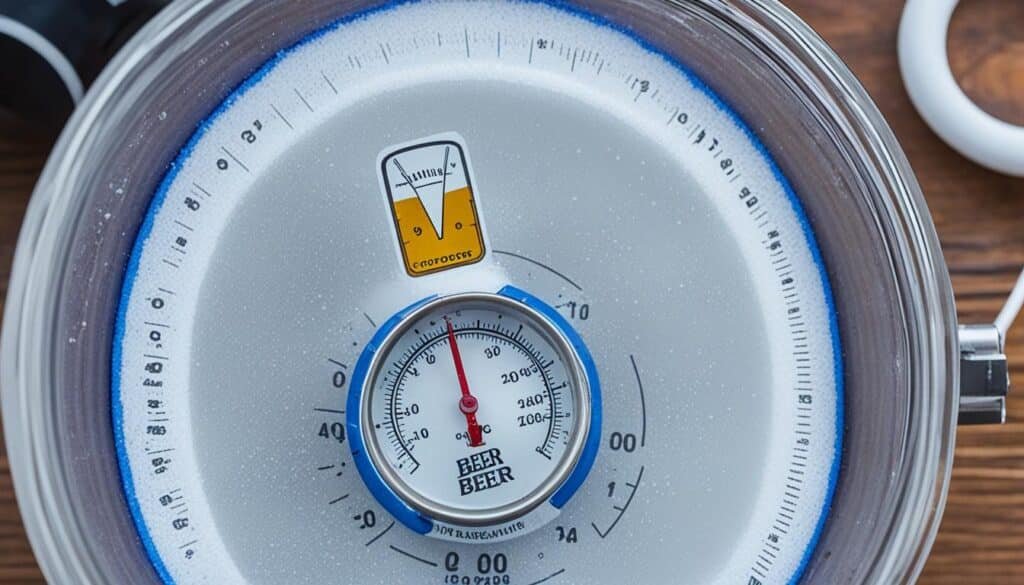Starting the beer fermentation journey is key for South African beer lovers. It’s where sugars in malt turn into alcohol and carbon dioxide with yeast’s help. This process makes the unique tastes and smells we love in our favourite beers.
Homebrewing in South Africa is growing fast. People want to make their own craft beers. Groups like BeerLab, BeerGuevara, and The Winemakers’ Club help this growth. They offer education and resources, making brewing better for everyone.
Key Takeaways
- Beer fermentation transforms sugars into alcohol and carbon dioxide.
- Yeast plays a pivotal role in creating unique flavours in South African brews.
- Homebrewing is becoming increasingly popular, supported by local suppliers.
- Understanding the brewing process enhances appreciation for diverse beer styles.
- Engagement in local homebrewing clubs offers valuable learning and sharing opportunities.
The Importance of Beer Fermentation in the Brewing Process
Beer fermentation is key to making great beer. It turns sugars from malt into alcohol and carbon dioxide with yeast. The type of yeast and how it ferments affects the beer’s taste and smell.
Understanding how fermentation works
Fermentation is vital in brewing. It starts with mashing grains with water, making wort full of sugars. Yeast then eats these sugars, making alcohol and flavour compounds. The temperature and time of fermentation shape the beer’s taste.
The role of yeast in beer fermentation
Yeast is crucial for the beer’s character. Different yeasts give off unique tastes, from fruity to clean. By controlling yeast with temperature and oxygen, we can get the flavour we want. Choosing the right yeast helps make amazing beer. For more details, check out the yeast fermentation process.
Choosing the Right Fermentation Vessels
Choosing the right fermentation vessel is key in homebrewing. It affects how the beer ferments and its quality. In South Africa, we see many types of vessels, each with its own benefits and things to think about.
Types of fermentation vessels used in South Africa
There are different vessels for different brewing styles and tastes. Here’s a look at some main options:
| Type | Advantages | Best For |
|---|---|---|
| Stainless Steel Fermenters | Durable, easy to clean, resistant to scratches | Experienced homebrewers, commercial breweries |
| Plastic Bucket Fermenters | Cost-effective, lightweight, great for beginners | Newcomers, budget-conscious brewers |
| Glass Carboys | Non-porous, allows visibility of fermentation | Aesthetic-focused homebrewers |
| Conical Fermenters | Simplifies sediment removal, advanced features | Experienced brewers seeking enhanced functionalities |
| Wooden Barrels | Adds unique flavours, traditional ageing | Brewers of sour beers, spirits, and wines |
Factors to consider when selecting a fermenter
When picking a fermenter, think about these things:
- Size: Think about how much we want to brew. A 5-gallon fermenter is good for small batches. For bigger batches, you might need a larger one.
- Material: Each material has its own benefits. Stainless steel is durable, glass lets you see the fermentation. Plastic is a cheaper option.
- Temperature Control: Choose vessels with insulation or temperature control to keep fermentation conditions right.
- Ease of Cleaning: Pick vessels that are easy to clean to avoid contamination risks.
- Space Availability: Make sure you have enough space for big vessels like conical and pressure fermenters.
Keeping fermentation vessels clean and sanitising them before use is important for good brewing. By thinking about our options carefully, we can get the best results from our homebrewing with the right fermenters.
Beer Fermentation: Stages and Timeline
Exploring the beer fermentation process shows us different stages that shape the beer’s quality and taste. Each stage is key, especially primary fermentation, which is crucial for flavour and alcohol creation.
Primary fermentation and its significance
Primary fermentation lasts about one to two weeks, depending on the beer type. Yeast eats the sugars in the wort, making alcohol and flavour compounds. It’s important to watch the yeast closely during this stage. This affects the beer’s alcohol level and taste.
Keeping the right temperature and making sure the yeast is healthy helps this stage go well.
Secondary fermentation and maturation period
After primary fermentation, we move to the secondary phase, which includes maturation. This stage helps the beer get more complex and smoother. Flavours blend and unwanted tastes decrease as yeast keeps working.
Managing this period well can make the beer clearer and more stable. Waiting patiently during this time can lead to a better beer.
Monitoring yeast activity during fermentation
Checking yeast activity is key at every fermentation stage. We should check the gravity daily to see if fermentation is on track. Making changes if needed helps ensure the beer quality. Understanding these stages helps us make unique and quality beer, improving our brewing at home. For more details, see the beer brewing process.
| Fermentation Stage | Duration | Description |
|---|---|---|
| Lag Phase | 3-15 hours | Yeast acclimatises and prepares for fermentation. |
| Active Phase | 4-8 days | Yeast consumes sugars, producing alcohol and flavours. |
| Stationary Phase | 3-10 days | Yeast growth stabilises as fermentation slows. |
| Conditioning Phase | Varies | Final adjustments occur, improving clarity and flavour. |
Temperature Control for Optimal Fermentation
Keeping the right temperature during fermentation is key to making great beer. The way yeast works and how fast it ferments is affected by temperature. Each type of yeast has its ideal conditions for fermentation. For example, brewer’s yeast works best between 80-90℉ (26-32℃). But, Kveik yeast from Norway can handle higher temperatures without making bad flavours.
Importance of temperature in fermentation
The temperature affects yeast’s inner workings. Higher temperatures make yeast work faster, using up sugars quickly. This affects the beer’s taste, adding flavours like esters and phenols. For ales, the ideal temperature is 68 to 72 °F (20 to 22 °C). Lagers need cooler temperatures, between 45 to 55 °F (7 to 13 °C).
Knowing these temperatures helps set the right fermentation conditions for each beer type.
Methods for maintaining temperature control
There are ways to keep fermentation temperatures steady. A temperature-controlled chamber keeps conditions constant, preventing bad flavours from temperature changes. Heating belts can warm up small batches when needed. Digital and analog temperature controllers can keep the temperature within a narrow range, usually 1 to 4 degrees Fahrenheit.
Keeping the right temperature during fermentation is crucial. It helps get the desired taste and ensures full fermentation for the best quality beer. For more on beer ingredients, check out this source.

Essential Equipment for Homebrewing in South Africa
Starting with homebrewing means getting the right tools. A basic brewing kit is the first step, giving us everything we need. Choosing quality equipment is key for making great beer and improving our skills.
Basic brewing kit essentials
A basic beer fermentation kit costs R250.00 and includes important parts like:
- 25L fermentation bucket
- Tap for easy dispensing
- Airlock for controlled fermentation
- Temperature strip for monitoring
This kit is great for beginners. It makes 23 litres of beer, ideal for those wanting to explore more. It fits into the Beer Brewing Tools and Fermentation Equipment market in South Africa, helping new brewers.
Upgrading your equipment for enhanced brewing
As we get better at brewing, we often look to upgrade our gear. Tools like a mash tun help with all-grain brewing, giving us deeper flavours. A boil kettle is also key for the right hop taste.
Ketelkraal offers a wide range of Beer Starter Kits and supplies for all brewers. Upgrading our equipment not only betters our beer but also makes brewing more fun.
Common Challenges in Beer Fermentation and How to Overcome Them
Starting our brewing journey means facing common fermentation challenges. Issues like contamination and poor fermentation conditions can affect our beer’s quality. It’s key to know how to handle these problems.
Dealing with contamination issues
Contamination happens when bad bacteria or yeast get into our beer. This can ruin the taste and quality. To stop this, we must keep everything super clean.
Clean and disinfect all equipment after each batch. This stops different yeast strains from mixing and keeps unwanted yeast away. Checking the yeast’s health regularly helps spot contamination risks early.
Pitfalls of improper fermentation conditions
Bad fermentation often comes from wrong conditions like uneven temperatures or not enough oxygen. This can make the beer stick at certain stages, leaving it unfinished. Or, it might not ferment fully, making the brewing take longer.
Keeping an eye on the fermentation temperature is crucial. Wrong temperatures can make the beer taste bad. Also, having enough oxygen helps the yeast grow and ferment well.
Keeping detailed records of each brew helps us manage yeast health. This info helps us make better batches in the future.
| Issue | Impact | Solution |
|---|---|---|
| Stuck Fermentation | High final gravity, unfinished beer | Monitor yeast activity, ensure adequate oxygen levels |
| Incomplete Fermentation | Prolonged fermentation period | Track fermentation progress and adjust conditions |
| Contamination | Off-flavours and undesirable aromas | Implement strict sanitisation protocols |
| Temperature Issues | Off-flavours, halted fermentation | Maintain consistent fermentation temperatures |
Conclusion
Mastering beer fermentation is key to making unique South African brews. We learn the science behind it to improve our brewing skills. Knowing how sugars like glucose and maltose work helps us get the right alcohol and taste in our beers.
Choosing the right fermentation vessels, like stainless steel or wooden casks, is crucial. It helps control germs and makes the beer better. Using plate heat exchangers for cooling makes brewing easier. These steps help us make top-notch craft beers that highlight our focus on taste and quality.
As we dive deeper into beer fermentation, we see how our passion and effort pay off. With each batch, we honour our brewing traditions and open doors for new innovations in South African beer making.
FAQ
What is beer fermentation and why is it important?
Beer fermentation turns sugars in malt into alcohol and carbon dioxide with yeast. This process is key for the beer’s taste and smell. It makes each beer unique and fun to drink, especially in South Africa.
How does temperature affect the fermentation process?
Temperature is crucial in fermentation. It affects how yeast works and how fast fermentation goes. Keeping the right temperature helps finish fermentation well and avoids bad tastes.
What are the key stages of beer fermentation?
Fermentation has several stages. The first stage, primary fermentation, lasts about one to two weeks. Then, secondary fermentation adds to the beer’s taste and smoothness.
What types of fermentation vessels are used in South Africa?
In South Africa, brewers use glass carboys, plastic fermenters, and stainless steel conical fermenters. Each has its own benefits for cleaning, keeping air out, and size.
What issues can arise during fermentation and how can we prevent them?
Problems like contamination and bad fermentation can happen. Keeping things clean and controlling temperature and air levels helps avoid these issues. This makes fermentation go well.
What equipment do we need for homebrewing?
For homebrewing, you need fermenters, hydrometers, and airlocks to start. As you get better, adding mash tuns and boil kettles can improve your brewing.
How does yeast selection impact our beer?
Yeast strains give our beer unique tastes and smells. Knowing about different yeasts helps us pick the right one. This is key for the beer’s taste and quality.
